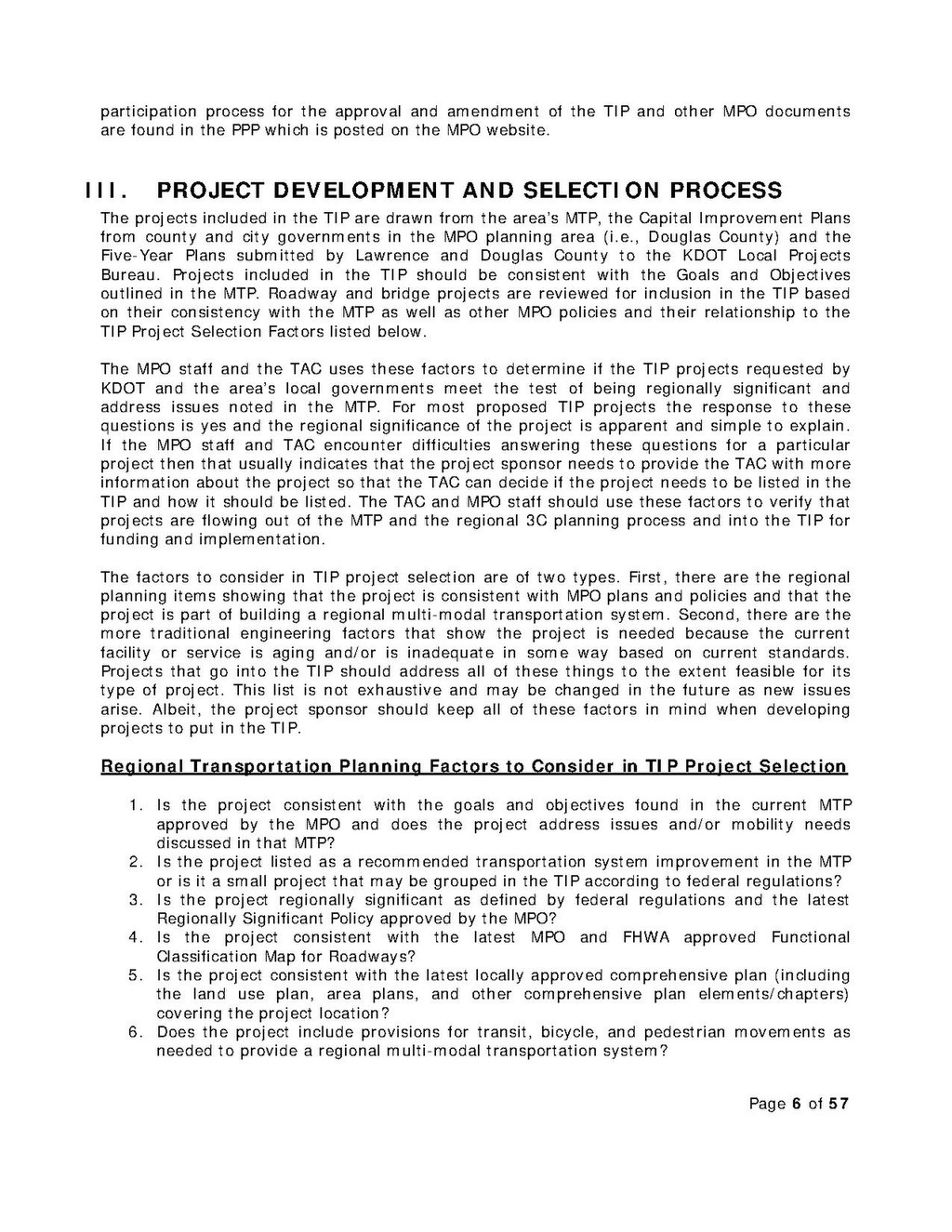participation process for the approval and amendment of the TIP and other MPO documents are found in the PPP which is posted on the MPO website.
III. PROJECT DEVELOPMENT AND SELECTION PROCESS
The projects included in the TIP are drawn from the area’s MTP, the Capital Improvement Plans from county and city governments in the MPO planning area (i.e., Douglas County) and the Five-Year Plans submitted by Lawrence and Douglas County to the KDOT Local Projects Bureau. Projects included in the TIP should be consistent with the Goals and Objectives outlined in the MTP. Roadway and bridge projects are reviewed for inclusion in the TIP based on their consistency with the MTP as well as other MPO policies and their relationship to the TIP Project Selection Factors listed below.
The MPO staff and the TAC uses these factors to determine if the TIP projects requested by
KDOT and the area’s local governments meet the test of being regionally significant and
address issues noted in the MTP. For most proposed TIP projects the response to these
questions is yes and the regional significance of the project is apparent and simple to explain.
If the MPO staff and TAC encounter difficulties answering these questions for a particular
project then that usually indicates that the project sponsor needs to provide the TAC with more
information about the project so that the TAC can decide if the project needs to be listed in the
TIP and how it should be listed. The TAC and MPO staff should use these factors to verify that
projects are flowing out of the MTP and the regional 3C planning process and into the TIP for
funding and implementation.
The factors to consider in TIP project selection are of two types. First, there are the regional
planning items showing that the project is consistent with MPO plans and policies and that the
project is part of building a regional multi-modal transportation system. Second, there are the
more traditional engineering factors that show the project is needed because the current
facility or service is aging and/or is inadequate in some way based on current standards.
Projects that go into the TIP should address all of these things to the extent feasible for its
type of project. This list is not exhaustive and may be changed in the future as new issues
arise. Albeit, the project sponsor should keep all of these factors in mind when developing
projects to put in the TIP.
Regional Transportation Planning Factors to Consider in TIP Project Selection
- 1. Is the project consistent with the goals and objectives found in the current MTP approved by the MPO and does the project address issues and/or mobility needs discussed in that MTP?
- 2. Is the project listed as a recommended transportation system improvement in the MTP or is it a small project that may be grouped in the TIP according to federal regulations?
- 3. Is the project regionally significant as defined by federal regulations and the latest Regionally Significant Policy approved by the MPO?
- 4. Is the project consistent with the latest MPO and FHWA approved Functional Classification Map for Roadways?
- 5. Is the project consistent with the latest locally approved comprehensive plan (including the land use plan, area plans, and other comprehensive plan elements/chapters) covering the project location?
- 6. Does the project include provisions for transit, bicycle, and pedestrian movements as needed to provide a regional multi-modal transportation system?
Page 6 of 57
